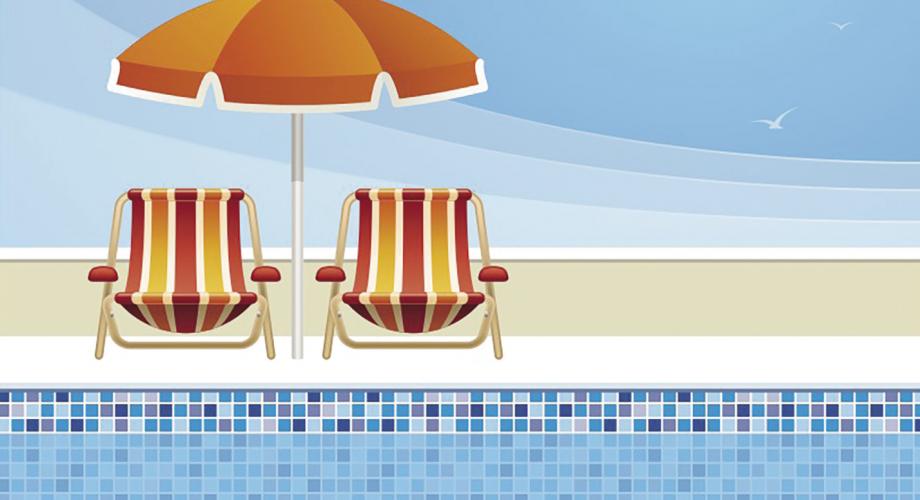Q. I have a pool at my apartment building and my technician is suggesting I convert to a salt system for sanitizing the water. Will the salt damage my pool or its equipment? How does a salt system work? Will swimming in the pool feel like an ocean swim?
A. We are big fans of salt systems for swimming pools. They feel great to swim in and you don’t have that chlorine smell on you when you get out. A saltwater system or “saltwater chlorine generator” is used to replace liquid or pellet chlorine with chlorine produced from salt in the water. The salt dissolves in the water, separating into sodium and chloride. By passing a low voltage electrical current between special metal plates and the water, the salt-cell will convert the chloride into chlorine in a process called electrolysis. The salt system will create the chlorine to sanitize the water, but without the chlorine smell, taste or feel. Not to mention, you will not need to handle or store a dangerous chemical.
Swimming in a salt pool is not like swimming in the ocean. A salt pool contains 3,000-4,000 PPM of salt while the ocean is approximately 35,000 PPM. A better reference point: A salt pool is about one tablespoon of salt in a gallon of water and the ocean is roughly 10 times that amount. The salt pool is closer to the salinity of your eye’s natural levels. A typical human eye’s salinity level is about 9,000 PPM.
While switching to a salt system pool has many advantages, there are a few downsides.
If the pool if very old, using a salt system may further corrode the pool’s metal skimmer and return pipes faster. Older pool heaters may also be adversely affected. Calcium may build up on the tile work. Newer pools use plastic pipes and pumps; the salt will not cause any damage to these items.
Q. My units all have dishwashers, and I am starting to get complaints from the residents that the dishwashers do not clean the dishes as well as they did when new. What is the problem and what can I do about it
A. A number of issues may cause this problem.
1. Check that the dishwasher’s filter or grates are not clogged. The filters are commonly found under the rotating spray arms at the bottom of the dishwasher. The filters normally snap in and out of place. Remove them gently and watch for broken glass.
2. Check the operation of the water inlet solenoid valve. It should open and close crisply.
3. Related to the inlet valve is the water level sensor. The sensor looks like a small, upside down cup or float, normally located at the front corner of the tub. Calcium buildup can sometimes cause the water level sensor float to malfunction, leading to not enough water being allowed into the dishwasher.
Cleaning the float area with vinegar should help.
4. Check the temperature of the water going into the dishwasher. The water should be at least 140 degrees.
5. Hard water is most likely the biggest hindrance to having clean-looking dishes. The dishes may actually be clean but look dingy or milky. Hard water will cause calcium and mineral deposits to adhere to all wet areas of the dishwasher and, over time, the dishes themselves. The rotating spray arms may fill with mineral buildup and clog. To remove the hard water deposits, run the dishwasher empty on its longest setting, usually the “pots and pans” setting. Add a few cups of vinegar to the water without soap or dishes. Run the dishwasher with clear water through a short cycle to flush the vinegar before using again.
6. Installation of a soft water system will greatly improve the performance of any dishwasher, as will using name brand dishwashing soap.
7. Install a water softener. You may have hard water as described above. Soft water will make a huge difference in calcium buildup in the dishwasher as well as the water heater.
Q. I am trying to be on top of my preventive maintenance this year. It is spring, so what do you suggest I look at first?
A. Summer is just around the corner and it may be a hot one. Prior to summer, it is essential to properly inspect and troubleshoot your HVAC units whether they are window, wall or central. Most A/C units fail or improperly work because of nonexistent or improper maintenance and not age.
Cleaning your A/C is the most inexpensive and critical maintenance procedure you can perform.
Here is our four-point check list:
1. Turn on the A/C and listen for unusual noises.
2. Inspect/clean or replace filters. Filters should be cleaned or replaced at the beginning of each major season, such as before summer and before winter.
3. Clean and repair damaged or bent fins. They can constrict proper air flow and decrease the cooling capacity of the A/C unit.
4. Clean out all dust and debris inside of the A/C pan or coils.
For a central HVAC unit, cleaning or replacing the main and return filters may be the limit on a DIY cleaning. A qualified technician should do any other work on a central heating and air unit.
Do you have DIY maintenance questions? Send them to [email protected].
